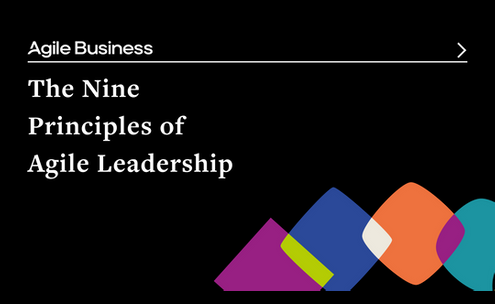Leadership, Culture and Governance are central to business agility. This blog is based on our deep-dive panel discussions around these three essential components.
Agile Leadership
Without an organisation’s leaders demonstrating and living the agile mindset, how can the rest of the organisation get on board with agile?
Quite simply, they can’t!
But what exactly is agile leadership and how can we get leaders to buy into it?
What agile leadership isn’t, is traditional command and control style management.
As Priti Vyas notes: “Leaders now have a much bigger role to play. This new era of leadership takes on very different dimensions – how do you enable the team and help them grow?
“Leaders are the ones who can create an enabling environment – for experimentation, for innovation, for psychological safety. That’s why I feel agile and leadership go hand in hand.”
Pam Ashby explains further: “Leaders need to change because the world has changed. They are no longer there to have the answers but to develop everybody’s growth. They need to walk the walk as well as talk the talk, to model what they see in others – they are like gardeners that prepare the right environment for everything to grow.”
Being an agile leader also means being vulnerable, as Tuukka Smolander explains: “Vulnerability is key – it’s probably the central component to trust and psychological safety.
“If you’re not showing that as a leader and making it okay to be vulnerable and share your uncertainties, then how can you expect anyone else to do it?”
Equally, Elizabeth Venter adds: “It’s about being adaptive and responsive.”
Okay, but how can we get leaders’ buy-in?
It’s no secret that leaders are busy people, for whom agile may be new, just as it is for their teams, and, as Vikram Jain notes: “There is often a negativity around agile. Convincing people to take themselves out of their ‘busynesss’ and learn something new is hard.”
He suggests therefore ‘agile safaris’- getting leaders who’ve been on the journey to meet other leaders and help them.
“Using data to highlight the problem is also really important”, he adds.
“Try to base conversations on data rather than emotion. We do review sessions with leaders to see what’s working and what isn’t.
“We get leaders to score themselves against a number of principles – where they think they are in terms of ‘action before perfection’ for example. Using data is a really powerful way of keeping the whole thing live rather than just having it as a poster on the back of the door.”
Elizabeth Venter stresses ‘the power of invitation’: “Inviting leaders in could be a very powerful technique to not have it feel threatening.”
She adds: “It’s incredible when leadership leans in to the change and becomes the force for change instead of leaving it to the team.”
Feedback is crucial too, she says, “Leaders need time to stand back, reflect and look at feedback as that’s how organisations improve, even if that feedback is sometimes negative or difficult to hear.”
Agile Culture
‘Culture eats strategy for breakfast’, Peter Drucker
To be truly agile, rather than just being seen to be doing agile, requires an agile culture as an absolute necessity.
“Culture permeates every aspect of an agile way of working”, notes Pam Ashby.
So what are the essential elements of such a culture?
Here’s what our panel pinpointed:
- Collaboration
- Continuous learning
- Customer, customer, customer!
- Perfect is the enemy of good – John Smart – good is good enough, perfection takes too long!
- Be clear on what you are trying to achieve – results should be defined in terms of outcomes, not outputs
- Transparent communication
- Leaders and HR need to walk the walk as well as talk the talk – they need to go first and live those agile principles.
- Be colleague focused. Understand the challenges and impediments in the culture and work with leaders to change the behaviour and encourage the right culture.
As with all other aspects of agile, an agile culture starts with an organisation’s leaders. Jim Ewel notes: “People watch executives so closely to see if they’re walking the walk so I challenged my team to call me out when I wasn’t performing to what my standards were. I had to make a constant effort to NOT always be the first to speak.”
Emma Bradley adds: “Quite often leaders aren’t aware of the impact of their behaviour on their teams. Leaders often think they’re helping by asking questions but often they are actually stopping the work or diverting people.
“We need to help leaders understand that they cast a long shadow and that their well-intentioned interventions are actually not always helpful.”
For Pia-Maria Thoren, motivation is key: “Finding out what everyone is motivated by is a must. I think it’s very difficult for leaders to change their behaviour if, for example, they are rewarded individually— then they won’t be interested in collaborating. That would be a ‘structure-culture misfit’.
Jim expands on this: “I don’t think you motivate people – people motivate themselves. In Jonathan Smart’s book: ‘Sooner, Safer, Happier’, he says: ‘Talking about an Agile transformation is an anti-pattern for the success of agile’ – I mean, none of us want to be ‘transformed!’
“Sometimes we have to ditch the agile language and just ask people what drives them crazy, what keeps them from getting work done.”
How do you create an agile culture and what’s the benefit?
Both leaders and teams need to understand the benefits of an agile culture to behave in ways that drive that culture.
“You need to demonstrate that there’s a definite link between business performance and having the right culture”, says Emma.
“You need to do culture experiments, to identify the bad habits in your organisation, for example, leaders attending the same meetings as others to whom they’ve given the work – that’s a waste of time.
‘People support what they help create’
All change takes time however and, as Jim notes: “Changing the culture is a skill — I think it’s easier to start with something that’s a company strength and make it a little better, something you’re likely to have success with first, rather than starting with the worst thing.
“People support what they help create. Get them involved with the ‘why?’. They have to be involved with the creation of the plan to make any change in the organisation’s culture.”
Agile Governance
The very word ‘governance’ conjures up images of autocratic ‘rule’, so it is perhaps unsurprising that many agile organisations struggle to implement governance that works, that is effective.
“It is something that should help, not hinder the organization”, says Melissa Reeve. “It has to be more responsive to everything that’s going on in the marketplace.”
Susie Young adds: “The purpose of good governance is how to make good decisions effectively.”
Jan Otterbach agrees and expands on this idea: “It’s not just about making decisions, but making those decisions stick: We need to put the outcome in the centre, not the output.”
Susie cites some decision making guardrails one organisation she worked with used:
- Is it in the best interest of the customer?
- Is it safe?
- Is it in the best interests of colleagues across different departments – can they support the change?
- Is it going to introduce technical debt?
- Is it an experiment and could it bring the whole team or organisation down?
“The purpose of good governance is how to make good decisions effectively.”
“It’s about how we reduce the time to make decisions without changing the risk profile”, she adds. “It’s about empowering the best people to make the decisions to make them.”
Susie acknowledges that an executive may need to go to the decision maker and help them make the decision but agrees with Colleen Dunn Hartoonian that: “Once people are empowered to make the decision, they mustn’t be undermined.”
Melissa rejects the idea of governance being all about rules, citing Reed Hastings’ book: ‘No Rules Rules’.
She explains: “You can’t create a rule for every situation. People are always going to make mistakes but is it safe to make those mistakes? Hastings says you should get the highest quality people, increase the candour and transparency around governance and remove controls.”
So how can organisations improve their governance?
“Remember customer centricity”, says Melissa. “Governance is the organisation and the people of the organisation. Are those responsible for governance talking to other people in the organisation and seeing if it’s working? Are they continually improving their governance processes to serve the organisation as a whole?”
Colleen adds: “You’re never done with governance. It’s an evolution.
“The most important thing is that you’re maintaining communication with your leaders and your teams to make sure your governance is actually addressing the problems and issues that you have and that you’re not just sticking to a plan you made a year and a half ago that’s going to be either irrelevant or not addressing the business’ needs.
“Give yourself grace, know that it takes time.”
How can poor decisions be handled without affecting psychological safety?
“You need to celebrate failures as learnings”
Anyone can make the wrong decision , it’s how the error is handled that’s important. “You need to disentangle the person from the project – the person didn’t fail, the project did”, Melissa notes. “You need to celebrate failures as learnings.”
Emma agrees: “You can have blogs from leaders about their big failures and what they learned from them. We need to create a culture of leaders sharing that.”
Please note: blogs reflect the opinions of their authors and do not necessarily reflect the recommendations or guidance of the Agile Business Consortium.






